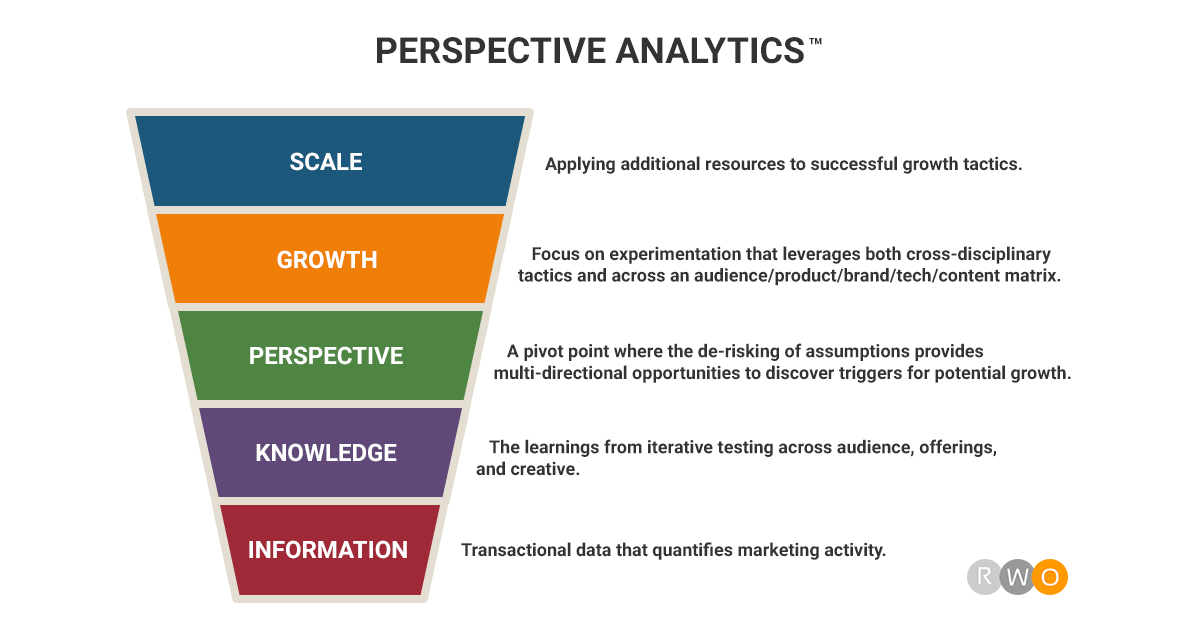PERSPECTIVE ANALYTICS ™
Perspective Analytics

Perspective Analytics: A Data-Driven Growth Process
What is Perspective Analytics?
“Perspective analytics is a process that helps marketers move from start to scale by targeting actionable insights instead of more traditional, linear data analysis/response approaches.”
Perspective Analytics represents an advanced methodology within the realm of marketing analytics, distinguished by its dynamic and multifaceted approach. This strategy transcends the conventional bounds of straightforward data monitoring and linear analysis techniques. Unlike traditional methods that often focus solely on data collection and basic interpretation, Perspective Analytics is designed to delve deeper into the data to unearth significant, actionable insights that can directly influence business strategies and outcomes.
At its core, Perspective Analytics aims to enhance decision-making by integrating various data points to provide a holistic view of the customer journey. It prioritizes value creation for both the business and its customers. By analyzing interactions, behaviors, and patterns from multiple perspectives, this approach helps identify unique opportunities for enhancing customer experiences and offers tailored, impactful solutions that address specific needs and preferences.
Furthermore, Perspective Analytics employs innovative tools and technologies to dynamically adapt to changing market conditions and consumer trends. This adaptability ensures that businesses remain agile, responsive, and competitive in a rapidly evolving marketplace. Through the strategic use of Perspective Analytics, organizations can gain a more profound understanding of their audience, optimize their marketing efforts, and drive meaningful engagement and growth.
Perspective Analytics: Stages and Approach
Information
The Information stage is foundational to Perspective Analytics. In traditional approaches, marketers often stop at collecting and quantifying transactional data. However, this stage serves as a base for a much higher climb. It includes gathering and synthesizing a wide variety of data, from user behavior and engagement metrics to sales data and customer feedback. This creates a comprehensive landscape of information that goes far beyond mere numbers.
The Information stage also involves advanced analytics techniques such as sentiment analysis, churn prediction, and customer segmentation. These techniques allow marketers to delve deeper into the “why” behind the “what,” empowering them to anticipate market trends and customer behavior more effectively. This holistic approach sets the stage for more insightful and strategic actions in the subsequent stages of Perspective Analytics.
Knowledge
After collecting a diverse set of information, the Knowledge stage focuses on turning this raw data into actionable insights. The information gathered is tested iteratively across different audience segments, product offerings, and creative content. These tests allow for hypothesis-driven experiments that can lead to breakthrough innovations.
This stage includes the application of machine learning algorithms and other advanced analytical tools to identify less obvious patterns and correlations. By employing a multidisciplinary approach, this stage creates a knowledge hub that is not just descriptive but predictive and prescriptive, informing what is likely to happen and what actions should be taken.
Perspective
Perspective is the pivot point in this analytical approach. Unlike traditional analytics, which operate in a linear fashion, Perspective introduces multidimensionality. It involves de-risking assumptions and using the acquired knowledge to view data from multiple angles. This stage allows for more adaptive strategies by identifying triggers and growth levers that may be less apparent.
By questioning existing assumptions and exploring unfamiliar avenues, marketers can unlock new opportunities for growth and develop a more holistic view of the business landscape.
Growth
The Growth stage is where acquired perspectives are applied through targeted experimentation. These experiments aren’t limited to traditional marketing avenues but span a matrix that includes audience, product, brand, technology, and content. The focus is on rapid iteration, quick learning, and agile implementation.
Successful tactics are optimized and scaled, while less effective ones are refined for re-testing or discarded. The aim is to discover significant improvements in performance and yield.
Scale
Scaling is the ultimate objective, achieved when there is consistent growth. This stage involves allocating resources—whether budget, manpower, or technology—to strategies and tactics that show promise. Scaling is about optimizing performance at every level to ensure that growth is sustainable long-term.
Continuous monitoring and feedback loops are critical at this stage, ensuring that scaling efforts align with performance and market conditions. The insights gained from scaling feed back into the earlier stages, creating a cycle of continuous refinement and improvement in the Perspective Analytics process.
Additional Principles of Perspective Analytics
Focus on Value for the Customer
Focusing on value-adds is about enhancing the customer experience. This could be as simple as a well-designed UI/UX or as complex as personalized recommendations based on user behavior. The goal is to make each touchpoint meaningful, creating loyal customers who not only make a purchase but become advocates for your brand.
Learn Quickly and Discard What Doesn’t Work
In a fast-paced environment, the ability to adapt is crucial. Organizations must quickly identify what works through rigorous testing, feedback, and iteration. Equally important is the ability to discard what doesn’t work, saving time and resources for more effective strategies.
De-risk Assumptions Across the Sales Funnel
Assumptions can become pitfalls in analytics. De-risking assumptions across the sales funnel ensures that each stage is optimized for efficiency and effectiveness. Predictive analytics and data-driven insights help organizations anticipate challenges and preemptively develop solutions.
Create Adaptive Responses within a Lean Marketing System
Markets are dynamic, and static approaches quickly become obsolete. Adaptive responses allow systems to pivot quickly in response to changes, ensuring that marketing strategies remain agile. In a lean marketing system, this adaptability enhances efficiency while keeping resources optimized for maximum impact.
Foster a Culture of Systemic Creativity and Innovation
A culture of systemic creativity and innovation integrates analytics into every decision-making process. This synergy fosters an environment where data informs creativity and vice versa. Over time, this approach produces better analytics results and drives continuous improvement and sustainable growth across the organization.
